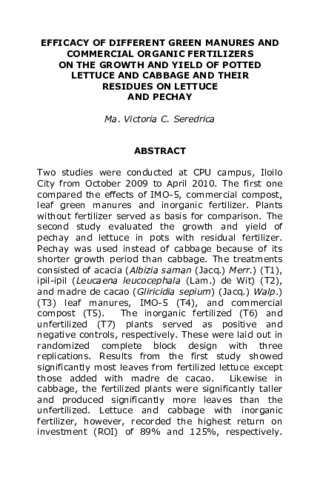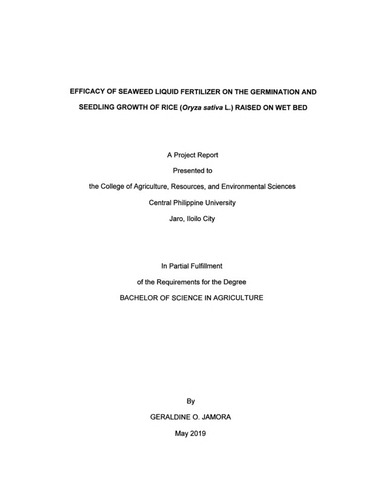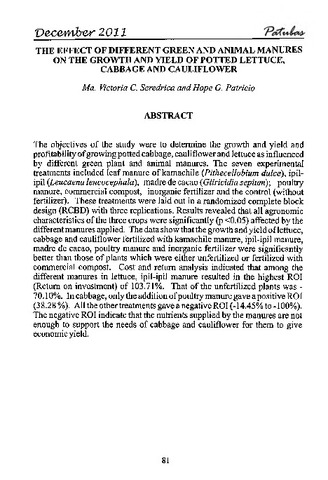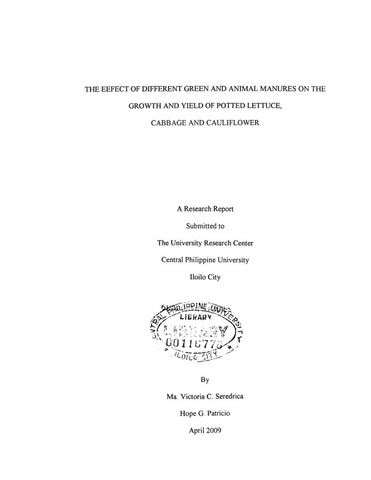Efficacy of different green manures and commercial organic fertilizers on the growth and yield of potted lettuce and cabbage and their residues on lettuce and pechay
| dc.contributor.author | Seredrica, Ma. Victoria C. | |
| dc.date.accessioned | 2021-01-11T05:32:28Z | |
| dc.date.available | 2021-01-11T05:32:28Z | |
| dc.date.issued | 2014-06 | |
| dc.identifier.citation | Seredrica, M. V. C. (2014). Efficacy of different green manures and commercial organic fertilizers on the growth and yield of potted lettuce and cabbage and their residues on lettuce and pechay. Patubas, 9(1), 1-23. | en_US |
| dc.identifier.issn | 1908-515X | |
| dc.identifier.uri | https://hdl.handle.net/20.500.12852/60 | |
| dc.description | Journal article | en_US |
| dc.description.abstract | Two studies were conducted at CPU campus, Iloilo City from October 2009 to April 2010. The first one compared the effects of IMO-5, commercial compost, leaf green manures and inorganic fertilizer. Plants without fertilizer served as basis for comparison. The second study evaluated the growth and yield of pechay and lettuce in pots with residual fertilizer. Pechay was used instead of cabbage because of its shorter growth period than cabbage. The treatments consisted of acacia (Albizia saman (Jacq.) Merr.) (T1), ipil-ipil (Leucaena leucocephala (Lam.) de Wit) (T2), and madre de cacao (Gliricidia sepium) (Jacq.) Walp.) (T3) leaf manures, IMO-5 (T4), and commercial compost (T5). The inorganic fertilized (T6) and unfertilized (T7) plants served as positive and negative controls, respectively. These were laid out in randomized complete block design with three replications. Results from the first study showed significantly most leaves from fertilized lettuce except those added with madre de cacao. Likewise in cabbage, the fertilized plants were significantly taller and produced significantly more leaves than the unfertilized. Lettuce and cabbage with inorganic fertilizer, however, recorded the highest return on investment (ROI) of 89% and 125%, respectively. Results from the second study revealed that lettuce grown in soil with residues of green manures and commercial organic fertilizers had more leaves, were taller, and out yielded the unfertilized plants and those previously applied with inorganic fertilizer. Results further showed that pechay with different manures had statistically similar leaf count and height but had significantly outperformed those with inorganic fertilizer (T6) and without fertilizer (T7). However, lettuce and pechay with residues of compost (T5) showed the highest ROI of 411% and 318%, respectively. Based on the results of the first study, it is concluded that it is profitable to use inorganic fertilizer (T6) in lettuce and cabbage production. However, it was the residue from commercial compost (T5) that sustained soil productivity and profitability of the second crop. | en_US |
| dc.language.iso | en | en_US |
| dc.publisher | Central Philippine University | en_US |
| dc.subject.lcsh | Compost | en_US |
| dc.subject.lcsh | Green manure crops | en_US |
| dc.subject.lcsh | Fertilizers | en_US |
| dc.subject.lcsh | Cabbage--Fertilizers | en_US |
| dc.subject.lcsh | Lettuce--Fertilizers | en_US |
| dc.title | Efficacy of different green manures and commercial organic fertilizers on the growth and yield of potted lettuce and cabbage and their residues on lettuce and pechay | en_US |
| dc.type | Article | en_US |
| dc.citation.firstpage | 1 | en_US |
| dc.citation.lastpage | 23 | en_US |
| dc.citation.journaltitle | Patubas | |
| dc.citation.volume | 9 | en_US |
| dc.citation.issue | 1 | en_US |
| local.subject | Green manures | en_US |
| local.subject | Organic fertilizers | en_US |
| local.subject | Residual fertility | en_US |
| local.subject | Urban gardening | en_US |
| local.subject.scientificname | Brassica oleracea | |
| local.subject.scientificname | Lactuca sativa | |
| local.subject.scientificname | Albizia saman | |
| local.subject.scientificname | Leucaena leucocephala | |
| local.subject.scientificname | Gliricidia sepium |
이 항목의 파일
This item appears in the following Collection(s)
-
Journal articles [25]
-
Patubas [110]
Patubas is a refereed research journal of Central Philippine University.





